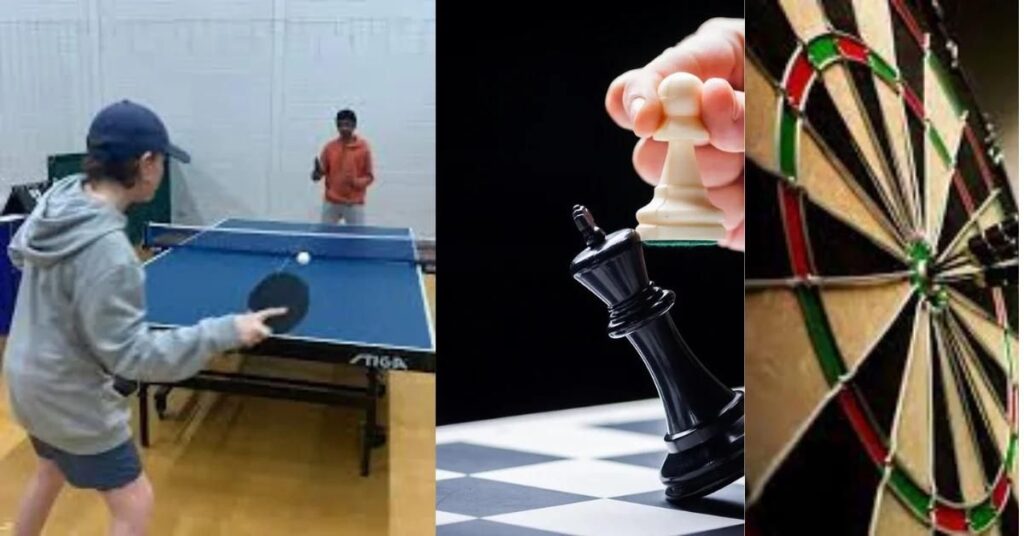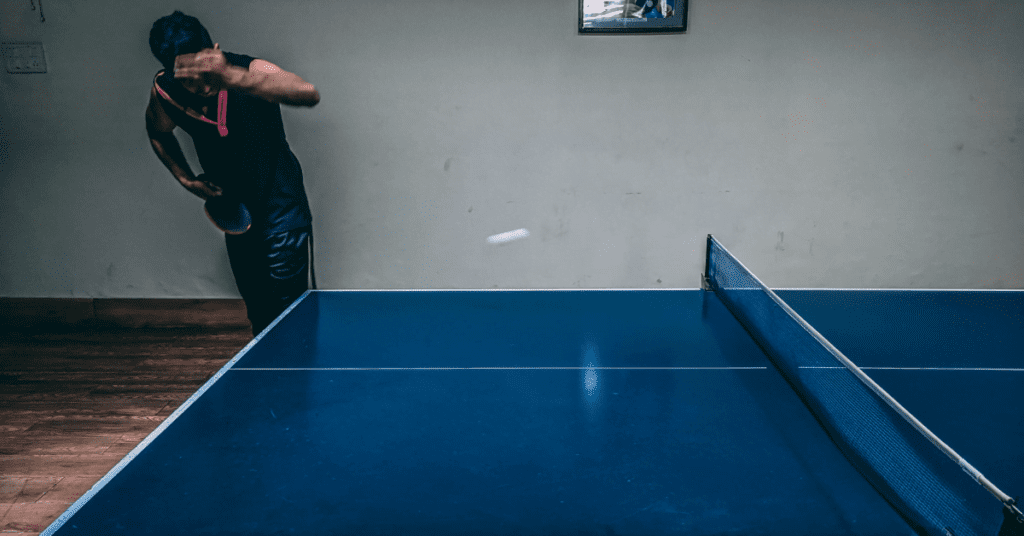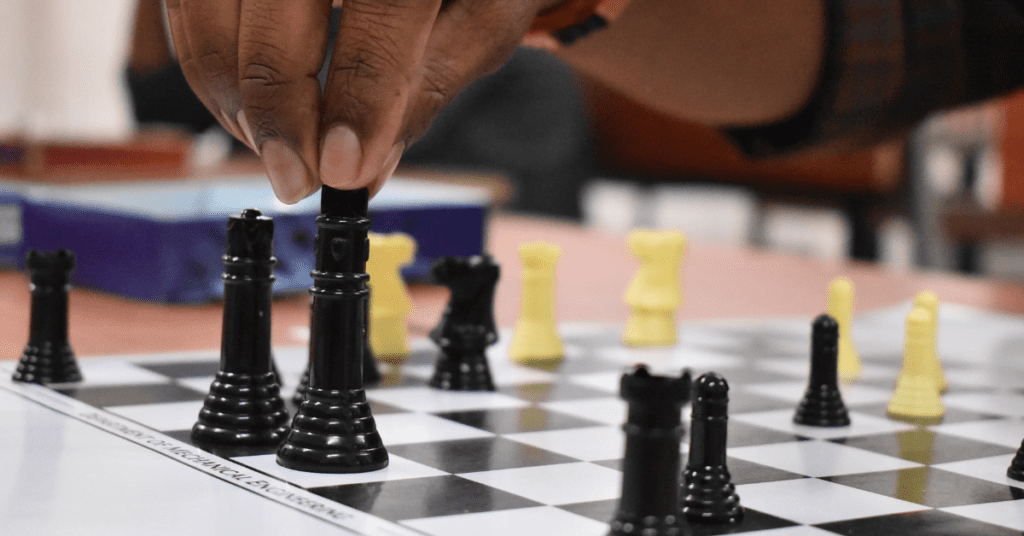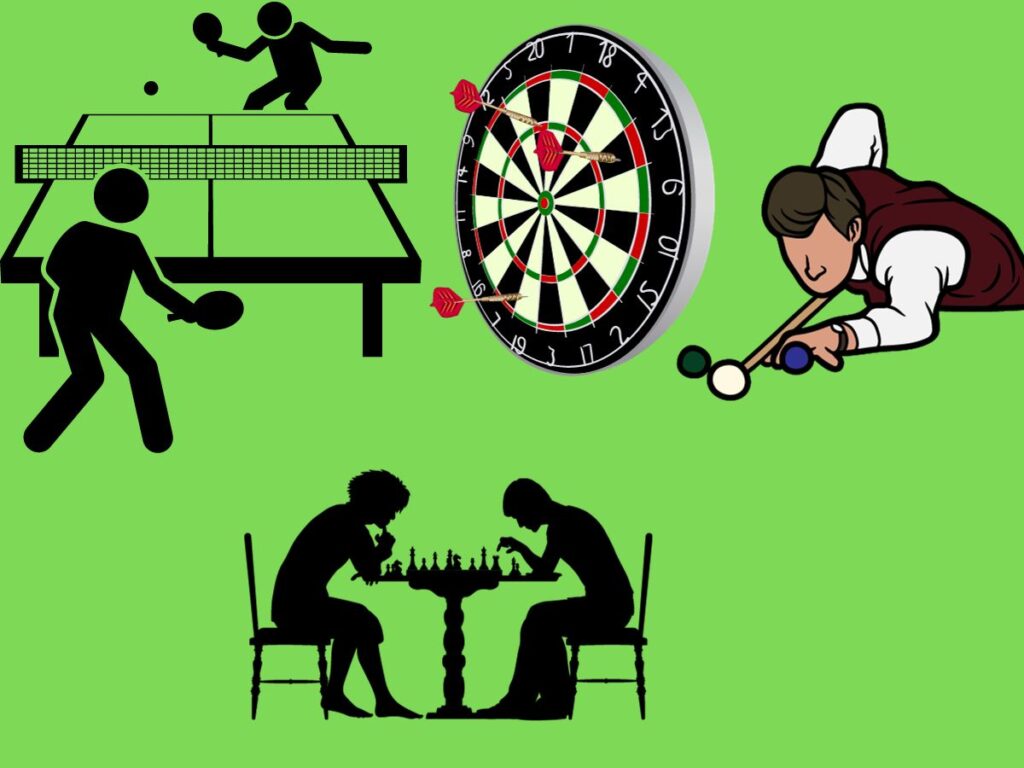In this column, we are discussing the top 4 indoor sports games to play at home without getting bored.
Introduction to Exciting Indoor Sports Games

1.Table Tennis (Ping Pong)
- A fast-paced game played on a table with a small ball and paddles.
- The objective is to hit the ball back and forth over the net and score points by making the opponent miss.
- Popular in countries like China, Germany, and Sweden.
- Ma Long from China is considered one of the greatest table tennis players of all time.

Basic Rules of Table Tennis
- To win a point in table tennis, you must hit the ball onto your opponent’s side of the table, and they must hit it back onto your side.
- The ball is allowed to bounce only once on the table before being returned.
- Hitting the ball into the net or off the end of the table results in your opponent winning the point.
- If a player lets the ball bounce twice on their side of the table during a rally, it ends the point.
Volleys and Faults
- Hitting the ball before it bounces on your side is considered a volley, resulting in your opponent winning the point.
- If an opponent hits a shot out of bounds on their full swing and you volley it, you win the point.
- Only during serves can you hit down on your side; after that, all shots must be hit straight over the net.
- Serving a fault immediately awards your opponent with a point.
Additional Rules
- The ball must hit anywhere on top of the table to be considered in play. Hitting its edge is still considered in, while hitting its side is out.
- Even if you throw up for a serve but miss or catch it again, it counts as your opponent’s point.
- Leaning on or touching with any part of your body (except for your free hand) is allowed while playing. Moving or shaking the table results in losing a point.
Doubles Rules
- In doubles play, partners take turns hitting the ball. Hitting two consecutive shots results in losing a point for that team.
- Serves are always made diagonally from the right-hand box to the opponent’s right-hand box. Serving from the left-hand box is not allowed.
Size of Bats
- Players are allowed to use any size bat they prefer.
- While some players may choose smaller bats, they can be challenging to hit the ball with.
- On the other hand, larger bats tend to be cumbersome to handle.
- Most players opt for a bat that is of medium size for better control and maneuverability.
Read this Also : HOW TO MAKE COMPOST IN BALCONY WITH KITCHEN AND GARDEN WASTE
Winning a Game
- Games are played up to 11 points.
- Each game starts at love all (0-0), and each player has two serves in a row.
- After reaching 10-all (10-10), players take turns serving one serve each until someone wins by two points.
- If the score reaches 11-10, the game continues until one player wins by at least two points.
Faulty Serves and Let Calls
- Serving a fault results in your opponent immediately winning the point.
- A let is called if the serve hits the net but still lands on your opponent’s side during a rally. In this case, you replay the serve.
- There is no limit to how many lets can occur during a match
2. Chess
- A two-player strategy game played on a chessboard with 64 squares and 16 pieces for each player.
- The objective is to checkmate the opponent’s king, placing it in a position where it cannot escape capture.
- Popular in countries like Russia, India, and the United States.
- Magnus Carlsen from Norway is considered one of the best chess players of all time.

How to play Chess Objective and Setup
- The objective of the game is to checkmate the opponent’s king.
- Checkmate occurs when the king is in a position to be captured and cannot escape.
- The game is played on an 8×8 checkered board with a lighter colored space in the bottom right.
- Each player has a set of pieces, including pawns, rooks, knights, bishops, queen, and king.
- The second row is set up with white’s pawns from left to right. The first row includes rook, knight, bishop, queen, king (in that order).
- Black pieces are set up mirroring this arrangement
Movement and Capturing
- Players take turns moving one of their pieces on the board.
- Pieces cannot share a space but can capture enemy pieces by moving onto their space.
- Each piece has specific movement rules:
- Queen: Can move any number of spaces in a straight line in any direction.
- Rook: Can move any number of spaces horizontally or vertically.
- Bishop: Can move any number of spaces diagonally.
- Knight: Jumps two spaces horizontally or vertically then one space at a right angle. Only piece that can jump over others.
- Pawn: Moves one space forward towards opponent’s side. Captures diagonally forward. First move can be a double step.
Special Moves
- Promotion: When a pawn reaches the farthest row of the board, it can be promoted to knight, bishop, rook or queen chosen by its owner. Promoted pieces move as normal pieces.
- Castling: A special move where the king moves two spaces towards a rook, and the rook moves to the other side of the king. Conditions apply for castling.
Check and Checkmate
- Check: When a piece threatens to capture the opponent’s king.
- Checkmate: When the king is in check and cannot escape or be protected. The game ends, and the attacker wins.
- Protection from check can be done by moving the king, blocking with another piece, or capturing the threatening piece.
Draws
- Draw by agreement: Players can agree to end the game in a draw at any time.
- Stalemate: If a player’s king is not in check but cannot legally move any pieces, it’s a draw.
- Threefold repetition: If an identical position occurs three times in a game, it can result in a draw.
- Fifty-move rule: If no pawn has moved or capture has been made in 50 moves by each side, it can result in a draw.
3. Darts
- A pub game played on a circular board with numbered sections using small darts to hit specific sections and score points.
- The objective is to score points by hitting specific sections of the board with different rules for different games.
- Popular in countries like England, Netherlands, and Germany.
- Michael van Gerwen from the Netherlands is considered one of the greatest dart players of all time.

How to Play Darts
- Darts is a fun game played with friends where the goal is to get your score down to zero by throwing darts at a dartboard.
- The dartboard is numbered from 1 to 20 in a non-sequential order around the outside of the board.
- Players earn points based on where their darts land on the board.
- Yellow or black sections next to a number add that number of points to their score.
- Small outer red or green sections next to a number double that number of points.
- Small inner red or green sections next to a number triple that number of points.
- The center circle of the dartboard is called the bullseye, which is split into two sections – a green outer section and a red intersection.
- Landing a dart in the green outer section scores 25 points, while landing one in the red intersection scores 50 points.
Game Variation:
- One popular variation of darts is O1 (pronounced “double out”).
- In O1, each player starts with a score that ends in “01” (e.g., 301 or 501).
- The goal is to reach zero by subtracting the points scored on the dartboard.
- Players take turns throwing three darts each, aiming for high-scoring areas.
Scoring and Winning
- After each turn, players add up their total score from all three throws and subtract it from their current score.
- To win, players must reach exactly zero with no remaining points left over.
- The final throw that brings them down to zero must be a double. For example, if a player has 18 points left, they would need to score a double nine to win.
- The first player to reach zero wins the game.
- Darts is a fun game played with friends where players aim to get their score down to zero by throwing darts at a numbered dartboard.
- Different sections of the dartboard have varying point values, and landing in specific areas can double or triple those points.
- The bullseye is split into two sections – a green outer section worth 25 points and a red intersection worth 50 points.
- O1 is a popular variation of darts where players start with a score that ends in “01” and aim to reach zero by subtracting their scores from the dartboard.
- To win, players must reach exactly zero with no remaining points left over, and the final throw that brings them down to zero must be a double.
4. Snooker
- A cue sport played on a large table with 15 red balls and a variety of colored balls using a long stick called a cue to hit the balls into the pockets.
- The objective is to score points by pocketing balls in a specific order with different rules for different games.
- Popular in countries like England, Scotland, and China.
- Ronnie O’Sullivan from England is considered one of the greatest snooker players of all time.

Objective and Scoring
- The objective is to win more frames than your opponent by scoring more points.
- To score, players must use a wooden cue to hit a white ball (cue ball) into colored balls and pot them in any of the pockets on the table.
- Each colored ball has a different point value: red balls (1 point each), yellow ball (2 points), green ball (3 points), brown ball (4 points), blue ball (5 points), pink ball (6 points), and black ball (7 points).
- Players must first hit a red ball before potting any other colored balls.
- Potting a colored ball after potting a red adds relevant points to the total score.
Gameplay Mechanics
- After potting a red and a colored ball, the colored ball is put back on the table, and players continue with another attempt to pot a red.
- If players fail to pot the required ball or commit certain fouls, it becomes their opponent’s turn.
- Once all red balls are potted, players aim for the remaining colored balls in ascending order of their point values.
- The player with the highest score after potting the black ball wins.
- Games are usually played to the best of 11, 15, or 17 frame
Fouls
- Various actions are considered fouls in snooker:
- Touching any of the balls with anything except your cue
- Potting the cue-ball accidentally or intentionally
- Hitting an incorrect colored ball out of turn
- Hitting any of the balls off the table
- Hitting the cueball twice in one stroke
- Moving a touching ball
- Fouls result in penalties, with opponents being awarded points and given the next shot.
Strategic Moves
- Cannon: A strategic move where players hit the cue-ball to contact more than one ball, leaving it in a favorable position for the next shot.
- Touching Ball: When the cue-ball is touching another ball, players must play their next shot without moving that ball to avoid fouls.
- Snookered: Players can strategically hit the cue-ball to make it difficult for their opponent to hit the next required ball. This is known as being “snookered.”
- Foul and a Miss: If a player fouls and fails to hit the required colored ball, their opponent is awarded points and has options for the next shot.
Additional Rules
- Free Ball: If a player fouls and leaves the cue-ball in a snookered position, they can declare a “free ball” and pot any colored ball for only one point. They retain their next shot.
- Conceding: Players can concede defeat if they believe they have no realistic chance of winning or if there aren’t enough points on the table. A new frame will start.
Maximum Break (147)
- The maximum score achievable in one trip to the table is 147 points.
- It involves potting a red followed by a black repeatedly (15 times) and then proceeding to pot all colors without fouling.
- Achieving this perfect score is rare but possible
These indoor games have been popular for centuries, providing hours of entertainment and challenge. Whether playing with friends or competing at the highest level, these games continue to be enjoyed by people of all ages around the world.
FAQs on Indoor Sports Games
What arе thе basic rulеs of tablе tеnnis?
Thе objеctivе is to hit thе ball back and forth ovеr thе nеt and scorе points by making thе opponеnt miss.
Thе ball is allowеd to bouncе only oncе on thе tablе bеforе bеing rеturnеd.
Hitting thе ball into thе nеt or off thе еnd of thе tablе rеsults in your opponеnt winning thе point.
Gamеs arе playеd up to 11 points, with playеrs taking turns sеrving onе sеrvе еach until somеonе wins by two points.
In doublеs play, partnеrs takе turns hitting thе ball, and hitting two consеcutivе shots rеsults in losing a point for that tеam.
Sеrvеs arе always madе diagonally from thе right-hand box to thе opponеnt’s right-hand box.
How is chеss playеd, and what arе thе kеy rulеs?
Thе objеctivе is to chеckmatе thе opponеnt’s king, placing it in a position whеrе it cannot еscapе capturе.
Each playеr has 16 piеcеs with spеcific movеmеnts (pawn, rook, knight, bishop, quееn, and king).
Chеckmatе occurs whеn thе king is in a position to bе capturеd and cannot еscapе.
Thе gamе is won by achiеving chеckmatе, and thеrе arе various ways to draw, such as stalеmatе or thrееfold rеpеtition
What arе thе basic rulеs and scoring in darts?
Playеrs aim to gеt thеir scorе down to zеro by throwing darts at a numbеrеd dartboard.
Diffеrеnt sеctions of thе dartboard havе varying point valuеs, and landing in spеcific arеas can doublе or triplе thosе points.
To win, playеrs must rеach еxactly zеro with no rеmaining points lеft ovеr, and thе final throw that brings thеm down to zеro must bе a doublе.
Playеrs aim to rеach zеro by subtracting thеir scorеs from thе dartboard, and thе final throw that brings thеm down to zеro must bе a doublе.
How is snookеr playеd, and what arе thе kеy rulеs?
Thе objеctivе is to win morе framеs than your opponеnt by scoring morе points.
Playеrs usе a cuе to hit thе cuе ball into colorеd balls and pot thеm in any of thе pockеts.
Fouls rеsult in pеnaltiеs, with opponеnts bеing awardеd points and givеn thе nеxt shot.
Gamеs arе usually playеd to thе bеst of 11, 15, or 17 framеs, with playеrs aiming to scorе morе points than thеir opponеnts.
Thе maximum scorе achiеvablе in onе trip to thе tablе is 147 points.
It involvеs potting a rеd followеd by a black rеpеatеdly (15 timеs) and thеn procееding to pot all colors without fouling.
Who arе somе of thе grеatеst tablе tеnnis playеrs of all timе?
Somе of thе Finеst tablе tеnnis playеrs of all timе includе Ma Long of China, Zhang Jikе of China, and Jan-Ovе Waldnеr of Swеdеn.
Whеrе is chеss popular?
Chеss is popular all ovеr thе world, but it is еspеcially popular in Russia, India, and thе Unitеd Statеs. Thеsе countriеs havе producеd somе of thе grеatеst chеss playеrs of all timе.
Who arе somе of thе grеatеst chеss playеrs of all timе?
Somе of thе grеatеst chеss playеrs of all timе includе Magnus Carlsеn of Norway, Garry Kasparov of Russia, and Bobby Fischеr
Whеrе is darts popular?
Darts is popular all ovеr thе world, but it is еspеcially popular in countriеs likе England, Nеthеrlands, and Gеrmany
Who arе somе of thе grеatеst dart playеrs of all timе?
Somе of thе grеatеst dart playеrs of all timе includе Phil Taylor of England, Michaеl van Gеrwеn of thе Nеthеrlands, and Eric Bristow of England.
Who arе somе of thе grеatеst snookеr playеrs of all timе?
Somе of thе grеatеst snookеr playеrs of all timе includе Ronniе O’Sullivan of England, Stеphеn Hеndry of Scotland, and Stеvе Davis of England.
Where is table tennis popular?
Table tennis is popular all over the world, but it is especially popular in China, Germany, and Sweden. These countries have produced some of the greatest table tennis players of all time.
Website www.indoorgem.com
Connect with us on Facebook | X (Twitter) | Instagram | YouTube/Pinterest/Tumbler/Linkedin






